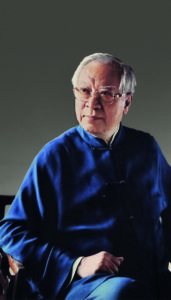歐豪年 AU HO-NIEN

“ 歐豪年先生兼有“撫孤松而盤恆”的晉代高士和民國時西學東漸文人雅士之風采,更是當今游於海峽兩岸以藝弘道的名士。秉持“折衷中西、融合古今”的藝術宗旨,在二三十年代的嶺南地區掀起了一場對中國畫的 “藝術革新”。創始人高劍父、高奇峰和陳樹人以高昂的藝術抱負、熾熱的革命精神,開啟了地區國畫的新篇章。
歐豪年先生1935年生於廣東茂名,後改吳川,自幼家學淵源,才情四溢。50年代遷居香港後,適逢嶺南畫派二代傳人趙少昂先生移居此處,續開嶺南藝苑。歐豪年拜其門下,成為嶺南畫派的再傳弟子。1970年,他南渡台灣,將嶺南畫派風恪引入此地,成為當地中國畫壇的一支新軍。多年來,歐豪年先生仰承師恩鴻業,秉持“折衷”精神,傳馨嶺南藝脈,不懈探索於畫派風恪與台灣地域文化的交融互通,使嶺南畫風成為台灣重要水墨風格之一。創作之外,其更不忘獎掖後學,在學院藝術教育中勤懇耕耘,桃李天下,不遺全力推動中國傳統藝術精神在中國繪畫、書法中的融滲和在新一代藝術家中的繼承。他本人也因之成為台灣畫壇卓有聲望的藝術大家。
歐豪年先生的作品以其中激盪的“雄強之質”而獨具特色。這不僅是嶺南畫派特有的筆勢氣概,更是他個人性情的彰顯,是其藝術自信的顯現。他傾慕黃河壺口的氣勢恢宏、萬里長城的蒼茫崇峻;欣賞雄獅猛虎的霸悍剛強、駿馬鷗鷺的意氣飛揚,大幹世界的壯麗景象與造物主的鬼斧神工使其驚嘆,可貴的是他將這一切生活的、生命的感動化入筆墨,並洋溢著其豪邁的才情。他作《雄獅出柙》:抒發“若無新變不為雄,往哲微言晨暮鐘。此時藝林沉寂甚,待聆清嘯振頑聾”的革新決心;他作《觀潮》,攫取如坡公一般“欲識潮頭高幾許,越山渾在浪花中”的慷慨氣概,不禁使人追憶“嶺南三傑”的藝術精神。與此同時,歐豪年先生始終立足自然,多年間從未停下寫生的步伐。他認為“寫生是水墨畫足以重新賦予現代性的基礎,也是個人與大自然獲得感性對話的起點”。如此,在“寫生”與”寫心的過程中,情隨物移,墨氣酣暢:筆走龍蛇間,獲得猶勁肆意之勢。歐豪年先生正是以這樣旺盛的創作精力、昂揚的藝術豪情和勤奮的寫生實踐:開張圖畫,再續嶺南畫派之時代新貌。”
-節錄自北京中國美術館吳為山館長文章
“Mr. Au Ho-Nien has the demeanor both of a Jin-dynasty hermit and of a Republican scholar when Western learning was introduced into China, and is more of a renowned man who shuttles across the Strait for the purpose of art. By initiating an “art reform” on Chinese painting during the 1920s and 1930s in the Lingnan region of China, with its artistic principle of “eclectic fusion of the Han Chinese and Western style, ancient and modern”. The founders of the painting school, Gou Gim-Fu, Gou Kei-Fung and Chan Syu-yan, all of whom entertained high artistic aspirations and a fervent revolutionary spirit, opened up a new chapter in the history of Chinese painting.
Born in Maoming County, Guangdong(now under the jurisdiction of Wuchuan) in 1935, Mr. Au was exposed to family tradition of literature and art from childhood. He moved to Hong Kong in the 1950s, at a time when Mr. Cheo Shao-ang, a second-generation painter of the Lingnan School, had just moved there and re-opened the Lingnan Art Studio he founded years ago. Mr. Au became a disciple of his, training in the Lingnan style of painting. In 1970 he moved to Taiwan, where he promoted the Lingnan style of painting and became a prominent figure in the Chinese painting community. In the ensuing years, he devoted himself to painting, holding fast to the ‘eclectic” spirit of the school, and his unremitting efforts made towards a fusion of his style with the regional culture of Taiwan made the Lingnan style one of the main styles of ink wash painting in Taiwan. He also taught art in school, sparing no effort to promote the spirit of traditional Chinese art in painting and calligraphy and among the younger generations of artists. He thus became a renowned art master in the painting community of Taiwan.
The works of Mr. Au are uniquely characteristic in that they evidently have a “quality of forcefulness”, which is not only a feature of brushwork peculiar to the Lingnan School of painting, but more of a manifestation of his personal disposition and of his artistic confidence. He adored the majesty of the Hukou Waterfall of the Yellow River and the magnificence of the Great Wall of China, and appreciated the awe-inspiring force of lions and tigers and the unbridled freedom of horses and egrets, marveling so much at the boundless beauty of nature that he expressed his affections for such in the form of painting He created Lion to express his determination to innovate in art; he created Tide Viewing to allude to great social changes, which is reminiscent of the artistic spirit of the three founders of the Lingnan School. Mr Au never ceases painting from nature over the years, which he thinks serves as the basis on which ink wash painting is enough to re-define modernity, and also the place to start for individuals to have dialog with nature. And that is why his creativity, lofty sentiment, and diligence in practice o art, that he is able to have rendered the Lingnan style of painting a new look”
——- Wu Weishan, Director of National Art Museum of China
